Life on Mars? A&M researchers take part in rover’s search for indications

NASA’s Perseverance Rover successfully descended onto the Jezero Crater on Mars’ surface on Thursday, and for approximately the next 687 days will search for signs of ancient microbial life on Mars. Two scientists in Texas A&M University’s College of Geosciences are part of this mission.
Marion Nachon, associate research scientist in the Department of Geology and Geophysics, is one of only 13 participating scientists selected by NASA for this mission. The participating scientists will conduct research using data collected by Perseverance and support the mission’s science operations. Nachon’s research will couple datasets from Perseverance’s Planetary Instrument for X-ray Lithochemistry (PIXL) and SuperCam instruments and rover cameras to characterize Mars’ geological record at the millimetric/micrometric scale.
“It is a great honor to be one of the 13 participating scientists selected,” said Nachon, who also conducted research supporting the Mars 2020 mission in Iceland in 2019.
Michael Tice, also an associate research scientist in geology and geophysics, is a co-investigator on the Mars 2020 PIXL Team. PIXL has a tool called an X-ray spectrometer that can identify chemical elements at a tiny scale, and it also has a camera that takes close-up pictures of rock and soil textures. It is one of the many technologically advanced tools on Perseverance that will look for signs of past microbial life on Mars.
Perseverance will advance NASA’s quest to explore the past habitability of Mars. The rover also has a drill to collect core samples of Martian rock and soil and store them for a future mission that would return them to Earth for detailed analysis. NASA missions before Perseverance have found that liquid water existed on Mars in the ancient past.

